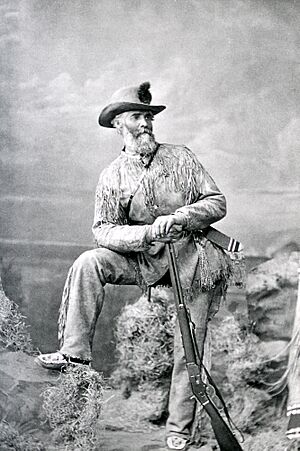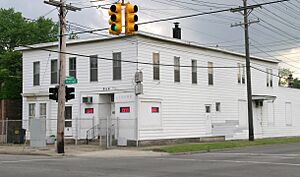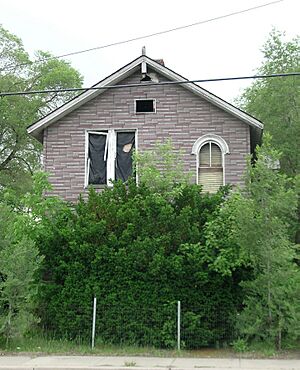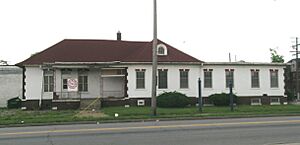Philetus W. Norris House facts for kids
Quick facts for kids |
|
|
Philetus W. Norris House
|
|
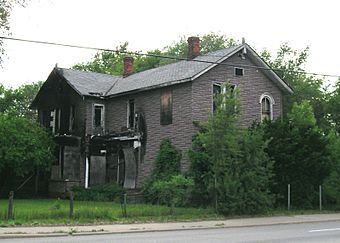
The side yard of the Philetus W. Norris House. The additional wing is hidden behind the tree to the left.
|
|
| Location | 17815 Mt. Elliott Avenue, Detroit, Michigan |
|---|---|
| Built | 1873 |
| Architectural style | Late Victorian |
| NRHP reference No. | 91001982 |
| Added to NRHP | January 28, 1992 |
The Philetus W. Norris House is a historic building in Detroit, Michigan. It is located near Mound Road and Davison Avenue. The house was built in 1873 by Philetus W. Norris. He later became the second leader of Yellowstone National Park. This house was added to the National Register of Historic Places in 1992. Sadly, a fire badly damaged it in 2016.
Who Was Philetus W. Norris?
Philetus W. Norris was born in 1821 in Palmyra, New York. His parents were John Norris, Jr. and Azubah Phelps. In 1826, his family bought land in Michigan and moved there.
Norris left school early to travel. He explored the Midwest, trapping animals and trading goods. In 1838, he settled in northwest Ohio. He married Jane K. Cottrell in 1845. They had four children: Edward, Aurelia, Ida, and Arthur.
When the Civil War began, Norris joined the fight. He worked as a spy and eventually became a Colonel. After the war, Norris moved back to Michigan. He started the town of Norris in 1873. He also had successful businesses in real estate and newspapers.
In 1877, Norris became the second superintendent of Yellowstone National Park. This meant he was in charge of the park. He held this important job until 1882. Philetus Norris died in 1885. He is buried in Woodmere Cemetery.
The Village of Norris
When Philetus Norris moved to Michigan, he managed land. This land belonged to soldiers from both sides of the Civil War. In 1873, he planned out the village of Norris. It was located in Wayne County, right where his house stands.
Norris wanted to name the town "Prairie Mound." But he convinced the Detroit and Bay City Railroad to build tracks through the area. The railroad put "Norris" on their station sign, and the name stuck.
The village of Norris had clear borders. These were roughly Seven Mile Road to the north, Mound Road to the west, Six Mile Road to the south, and Van Dyke Road to the east. To help his community grow, Norris drained a creek. This opened up land for farming. He also kept up a special road that connected Detroit and Mount Clemens. He even ran a tollbooth in the village.
Norris also built the Two Way Inn. This building was first used as the village's jail and general store. Norris lived there himself until his new house was ready. The Two Way Inn is still standing today. It is one of the only original buildings left from the old village, besides a nearby church and the Philetus W. Norris House.
Many German farmers settled in Norris. They sold their crops to people in Detroit. By 1880, about 250 people lived in Norris. The village had a train station, a hotel, a wagon shop, and many homes. In 1891, the village was renamed "North Detroit." Later, in 1924, the city of Detroit grew and took over the village. Today, you might see "Nortown" on some local businesses. This name reminds people of the old villages of Norris and North Detroit.
The Philetus W. Norris House
The Philetus W. Norris House was built in 1873. It was a two-story house built in a style called "Late Victorian." When it was new, the house had fancy wooden decorations. It also had brick chimneys and many leafy trees in its yard. Norris moved into this house from the Two Way Inn. He also added a section to the side of the house. He ran his real estate business from this part.
Norris moved to Yellowstone in 1877. But his family owned the house until 1916. They then sold it to William Lynch. Lynch used part of the house as a boarding house. This is a place where people can rent rooms. He sold the home in 1925. It was then changed into a building for three families.
Over the years, many different people owned and lived in the house. In 1965, it was changed back into a single-family home. This might have been when the outside was covered with asphalt siding. The house was lived in until 1991. After that, it was left empty and had unpaid taxes.
The house was added to the National Register of Historic Places in 1992. It was also named a historic district by the city of Detroit in 1995. A group called the Nortown Community Development Corporation bought the house. They planned to fix it up. But in 1999, someone set fire to the property, causing a lot of damage.
As of 2008, the house was still empty. Plans were still being made to restore it. However, on July 3, 2016, the Philetus Norris House was badly damaged by another fire. Only a small part of the house was left standing.


